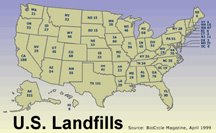Was waste product mishandled? Countywide official disputes claims, video made by Club 3000
The Times-Reporter
BOLIVAR - Video shown Friday demonstrates why a stench has permeated the region around Countywide Disposal and Recycling Facility, an environmental group’s leader contended.
Dick Harvey of Bolivar presented excerpts from a video to the Stark-Tuscarawas-Wayne Joint Solid Waste Management District during Friday’s board of directors meeting. He is president of Club 3000, a grassroots environmental group that monitors the landfill north of Bolivar in Stark County’s Pike Township.
Experts say an underground fire in the facility’s original 88 acres is causing the odor. Landfill officials contend it is from a chemical reaction.
“We did a file review in Stark County and found there were 70 odor complaints recorded about Countywide out of 31 days in March,” said Linda Harvey, who also is a Club 3000 member.
The video, taken Feb. 29, 1996, purportedly showed an aluminum waste product from Barmet Industries at Uhrichsville being unloaded at Countywide, then owned by Waste Management. The dusty gray product was in large bags that burst open when dumped.
“It was then just pushed into the other trash that was in the cell,” Harvey said.
“Tim Vandersall, general manager at Countywide, was at that time in the special waste programs,” Harvey said. “They knew back then what this product could do without proper handling.”
A landfill inner office memo in May 1993 to Greg Terwilliger, then site manager, gave instructions on how to handle aluminum dross/salt cake by storing material during wet weather periods in order to avoid disposal in rainy or snowy conditions.
The disposal facility shall minimize handling of material on top of the existing soil and avoid mixing matter with other solid waste, the memo states. The material then must be covered with additional soil at the end of the day and surface water shall be directed away from the active disposal area. The disposal method shall serve to encapsulate the waste within the landfill, the memo states.
In April 1994, Countywide, then owned by Waste Management, was accepting 3 million pounds of aluminum dross/salt cake a month from Barmet. The memo states that when the dross is mixed with water, ammonia gas may be generated. An effort should be made to minimize the surface area to minimize the release of ammonia gas, according to the memo.
A landfill office memo in January 1994 states that raw aluminum dross or salt cake is a material that not only can create a nuisance, but also is potentially harmful. In the presence of water, especially under alkaline conditions, aluminum hydrides also occur. Aluminum dross has been known to ignite and even explode when freshly exposed to water, or other gases may be generated in quantity such as carbon monoxide, hydrogen sulfide and arsine, according to the memo. This material is not currently considered a hazardous waste because there are no analytical criteria that clearly define “reacts violently to water, forms potentially explosive mixtures with water or generates toxic gases in a quantity to present a danger.” The United States Environmental Protection Agency is working on such analytical methods. Aluminum dross, at a minimum, must be considered potentially hostile to human health and the environment, according to the memo.
“We are being sued by Countywide and not allowed to inspect the landfill because we are gathering information,” Harvey said.
“When those bags of aluminum product exploded there was gray dust everywhere and I was concerned about the dozer operator and wondered what that did to him,” Harvey said. “The only thing the company changed was how the bags were taken off the truck.
“I am really tired of Countywide saying that they had no idea the dross was there. They had all the facts before them.”
Vandersall said the video was more than 12 years old, and the dross came in dump trailers and was encapsulated in the landfill.
“I don’t know that is aluminum dross in those bags in the video,” Vandersall said. “We dig a hole for those dusty bags.
“The heat issues have been at the site for about 15 years. If we had known, we would not have taken the dross, but we knew it could make ammonia. The dross is in the original 88 acres and we re-circulated the leachate,” Vandersall said.
“Your parent company (Republic Waste Services) says it is a chemical reaction, but experts say it’s a fire,” Tuscarawas County Commissioner Chris Abbuhl said to Vandersall.
“It is very hot, but it is a chemical reaction. We drilled 88 holes and pulled trash out of the hot spots and there is no fire, but the trash is very hot,” Vandersall responded.
“Do you have chemical engineers on your staff?” Tuscarawas County commissioner and board chairman Kerry Metzger asked Vandersall.
“When would Countywide realize aluminum dross had reacted,” Metzger asked. “When dross comes into contact with water, it causes a reaction and it reacts violently with liquid. Any junior high student could have read that and would have understood.”
Linda Harvey said that when the landfill was built, there were 89 stipulations in an agreement with Waste Management and Club 3000. Those stipulations have been changed and modified so often that there are only four of the 89 remaining, she said.












